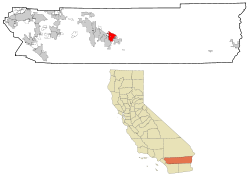Indio, CA
| City of Indio | |
|---|---|
| City | |

Indio during the 1950s: Stan Sniff, a local date grower's booth at the annual National Date Festival and Riverside County Fair, selling dates which is one of the region's most popular crops.
|
|
| Nickname(s): The City of Festivals | |
| Motto: "The place to be" | |
 Location in Riverside County and the state of California |
|
| Location in the United States | |
| Coordinates: 33°43′14″N 116°12′56″W / 33.72056°N 116.21556°WCoordinates: 33°43′14″N 116°12′56″W / 33.72056°N 116.21556°W | |
| Country | United States |
| State | California |
| County | Riverside |
| Incorporated | May 16, 1930 |
| Government | |
| • Type | City Council–City Manager |
| • Mayor | Lupe Ramos Watson |
| Area | |
| • Total | 29.189 sq mi (75.600 km2) |
| • Land | 29.181 sq mi (75.579 km2) |
| • Water | 0.008 sq mi (0.021 km2) 0.03% |
| Elevation | -13 ft (-4 m) |
| Population (April 1, 2010) | |
| • Total | 76,036 |
| • Estimate (2014) | 85,633 |
| • Density | 2,600/sq mi (1,000/km2) |
| Time zone | Pacific (UTC−8) |
| • Summer (DST) | PDT (UTC−7) |
| ZIP codes | 92201–92203 |
| Area code(s) | 442/760 |
| FIPS code | 06-36448 |
| GNIS feature IDs | 1652727, 2410101 |
| Website | indio |
Indio is a city in Riverside County, California, United States, located in the Coachella Valley of Southern California's Colorado Desert region. It lies 23 miles (37 km) east of Palm Springs, 77 miles (124 km) east of Riverside, and 127 miles (204 km) east of Los Angeles. It is about 98 miles (158 km) north of Mexicali, Baja California on the U.S.-Mexican border. The word Indio is Spanish for Indian.
The population was 76,036 in the 2010 United States Census, up from 49,116 at the 2000 census, an increase of 55%. Indio was once referred to as "the Hub of the Valley", which was the Chamber of Commerce slogan in the 1970s—today the nickname is the "City of Festivals" because of cultural events held in the city, most notably Coachella Valley Music and Arts Festival.
Railroad line construction east out of Los Angeles began in 1873. Trains were operated to Colton on July 16, 1875, and to Indio (then Indian Wells) on May 29, 1876. Moving on eastward from Indio, the railroad reached the west bank of the Colorado River opposite Yuma on May 23, 1877 (a village known as Arizona City prior to 1873). There was delay in getting military authority to lay tracks across the Yuma Indian reservation, and it was September that year before the bridge was completed so trains could operate into Yuma. The Southern Pacific Railroad was to have joined those of the Texas & Pacific, one of several railroads then holding, or seeking, federal authority to build lines from various sections of the country west to the Pacific Coast. But the rail-head of the T & P was at a standstill far off in Texas, so Southern Pacific continued building eastward. (A Historical Sketch of the SOUTHERN PACIFIC 1869-1944 by Erle Heath Editor, The Southern Pacific "Bulletin", www.cprr.org/Museum/SP_1869-1944/).
The City of Indio came about because of the need of a halfway point for the Southern Pacific Railroad between Yuma, Arizona and Los Angeles. The engines needed to be re-filled with water. At first, the-would-be city was called Indian Wells, but because of so many other areas already called that, Indio – after a Spanish variation of the word "Indian" – was chosen. After the railroad's arrival in 1876, Indio really started to grow. The first permanent building was the craftsman style Southern Pacific Depot station and hotel. Southern Pacific tried to make life as comfortable as it could for their workers in order to keep them from leaving such a difficult area to live in at the time. It was at the center of all social life in the desert with a fancy dining room and hosting dances on Friday nights.
...
Wikipedia

